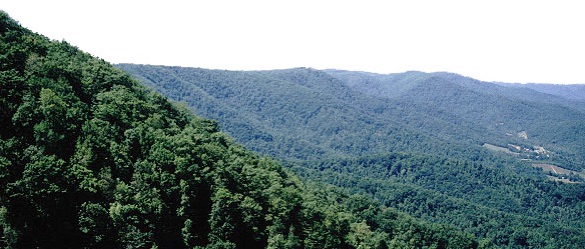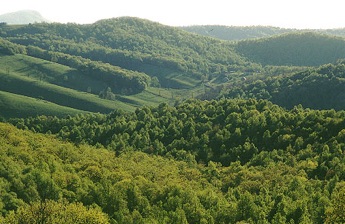
The Blue Ridge, part of the Appalachian Mountains, is an ancient chain of mountains and uplands stretching from Pennsylvania to Georgia. This beautiful region sports a great diversity of wildlife, plants and geology. It is a living landscape full of stories about nature.
-
https://brheritage.org/wp-content/uploads/2018/11/BlueRidgeSWVA-R-450x300.jpg
South of Roanoke, the Blue Ridge widens into a broad plateau. Here, we see the steep slope, or escarpment, called the Blue Ridge Front.
-
https://brheritage.org/wp-content/uploads/2018/11/LoversLeap-R-450x299.jpg
This photo looks eastward down from Lover's Leap in Patrick County. The escarpment rises from the lowlands upward toward the plateau.
-
https://brheritage.org/wp-content/uploads/2018/11/RC-Creek-450x600.jpg
Little Rock Castle Creek confluences with Rock Castle Creek before the waters flow off the Blue Ridge Mountains toward the Atlantic Ocean.
-
https://brheritage.org/wp-content/uploads/2017/04/TombStoneRocks.jpg
"Tombstones" at BRP MP 169 -- the rock (called schist) in these tombstone formations is harder than the surrounding rock, which eroded away more quickly
South of Roanoke, the Blue Ridge widens into a broad plateau. Here, we see the steep slope, or escarpment, called the Blue Ridge Front.
This photo looks eastward down from Lover's Leap in Patrick County. The escarpment rises from the lowlands upward toward the plateau.
Little Rock Castle Creek confluences with Rock Castle Creek before the waters flow off the Blue Ridge Mountains toward the Atlantic Ocean.
"Tombstones" at BRP MP 169 -- the rock (called schist) in these tombstone formations is harder than the surrounding rock, which eroded away more quickly
Blue Ridge Region Geology
The story of the Blue Ridge is tied to the history of the Appalachian Mountains and continental drift. About 450-500 million years ago, the ocean to the east of what is now North America began to get smaller as continents moved closer together. The name of this ocean was the Iapetus Ocean; the Atlantic would not form until later. About 280 million years ago, the ocean disappeared as Africa collided with North America. read more . . . The energy of collision gave rise to the Appalachian Mountains. The Blue Ridge was formed as a part of this process. It is composed of ancient rocks originally part of the deep "basement" of our continent. They were forced up to 100 miles westward, up over younger rocks along an enormous fault line. The collision was part of the process creating the super continent Pangea. The Blue Ridge was in the middle of this continent, far from the sea. About 220-180 years ago, Pangea began to break up as the forces of continental drift pulled its parts way from each other. A new ocean, the Atlantic Ocean, began to open up east of the Blue Ridge. The forces of the collision and the later pulling apart gave the rocks of the Blue Ridge their present structure. It was the slow erosive effects of rivers and streams that carved the land, creating its present appearance.
The Blue Ridge is not all mountains. South of Roanoke it widens into a broad plateau.

Escarpment & Plateau
Not all of the Blue Ridge is mountains. South of Roanoke, Virginia, the Blue Ridge Mountains widen to form the Blue Ridge Plateau. Once you reach the top of the escarpment, the rolling plateau spreads out before your eyes. This plateau begins narrowly just south of Roanoke and widens to nearly 50 miles. Mount Rogers rises from this plateau. The origin of the plateau lies in the history of the region's rivers.
Colliding continents gave Blue Ridge rocks their present form and location. They did not, though, give the Blue Ridge its present appearance. Water did that. Millions of years of slow erosion carved the mountains and plateau that we know today.
The Blue Ridge of southwestern Virginia marks the second largest drainage divide in North America. It is the divide between rivers that drain toward the Atlantic and those that drain to the Gulf of Mexico. (The largest divide is the Continental Divide, the division between lands that drain to the Pacific Ocean and those that drain to the Atlantic and Gulf.) read more . . . Before the continents pulled apart, opening the Atlantic Ocean, the rivers in our region drained northward. The New River still reflects this ancient pattern that predates the rise of the Appalachian mountains. Once the Atlantic opened, however, the eastern region began draining into the Atlantic. The Blue Ridge streams in the Atlantic drainage drop steeply and flow rapidly. They reach the Atlantic in a few hundred miles or less. Most of this drop of thousands of feet happens in the first few miles. These energetic streams carry lots of sand and gravel that cut deep stream beds and valleys. As a result, they carve their way into the Blue Ridge and back into the plateau. Over millions of years, the plateau gets smaller and smaller. The waters of the New River, tributaries of the Tennessee River and other rivers on the plateau find their ways to the Mississippi River. They eventually reach the Gulf of Mexico after traveling about 1,500 miles. For this reason, the rivers on the Blue Ridge Plateau are much more gentle and slower moving than those draining to the Atlantic.
The Atlantic drainage is slowly "stealing" rivers from the plateau and diverting them to the Atlantic through a process called stream piracy.
Stream Piracy
Stream piracy plays an important role in shaping the Blue Ridge.
Piracy? Yes! As rivers flowing to the Atlantic cut back into the Blue Ridge, they cut into the gentler creeks and rivers on the plateau. When this happens, the upstream portions of rivers flowing to the Gulf of Mexico are captured and begin flowing to the Atlantic. These captured (or pirated) streams become energized, flowing more rapidly and cut more quickly into their beds as they tumble down the Blue Ridge to the nearby sea. They are rejuvenated as mountain streams and begin to carve back into the plateau.
The headwaters of the James and Roanoke rivers have captured portions of the New River on the northern side of the Blue Ridge. Thus, the Blue Ridge in more northern parts of Virginia is cut on both sides, creating the Blue Ridge Mountains. However, these rivers have not reached far south of Roanoke, leaving the Blue Ridge Plateau. In time, though, they will cut farther back into the plateau and the mountains will slowly extend southward.
There are a number of excellent websites dealing with the modern theory of plate tectonics. Check out:
The Paleomap project at the University of Texas at Arlington.
Paleogeography Through Geologic Time by Ron Blakey at Northern Arizona University.

